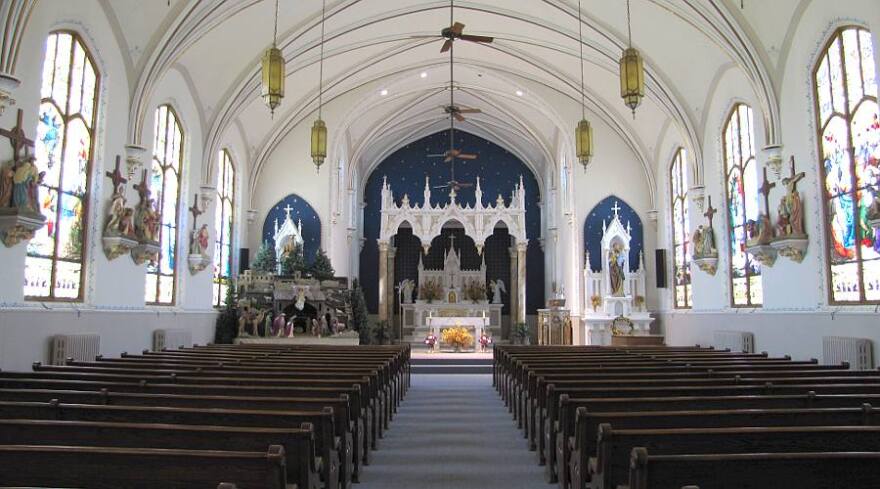Windhorst, KS is one of those prairie communities that doesn’t exist anymore except for a lonely church and outbuildings. Oh, there is a brown and white road sign pointing past a steep railroad track embankment over which the spire of the ornate church peeks
I’m Kathleen Holt of Cimarron, KS and I’ve driven over that track to explore the historic church and outbuildings mostly because I am curious about the lives and dreams of those who built this impressive facility in – well, in the middle of nowhere it would seem.
What does the Immaculate Heart of Mary Catholic Church built in 1911-1913 have to do with Burning Beethoven, you ask? This small, rural church on the prairie, out there by itself instructs us, helps us understand what motivated those early immigrants, what dreams and goals and fears those who came to the prairie bought with them. It explains many of the questions our current read inspires.
According to the 1880 census, Windhorst was settled by people born in Germany. The 79 families there at the time, however, emigrated from Ohio, Illinois, Kentucky, Indiana and Iowa. In 1878, the community was settled by members of the Cincinnati based German Catholic Aurora Homestead Association. St. Mary’s Catholic Church (later Immaculate Heart of Mary) stood at the center of the settlement and was the largest church with 175 parishioners. It is said that the core families who built the first church did so before barns and sometimes homes were built emphasizing the importance of faith in their lives.
Today, the early 20th Century Gothic Romanesque Revival facility with its gabled nave fronted centrally by a tower which is capped with a single spire stands as a reminder of those dreams. Although decommissioned in 1997, area residents committed to the church have preserved the structure which is used for concerts, special events and prayer groups. Elaborate and colorful stained-glass windows depict scenes from the New Testament. It is significant that the pews, stations of the cross, statuary, a baptismal font, and other fixtures were installed in 1913, just before World War I, hopes and dreams.
In the early part of the 20th Century, the church population grew both as a mission church serving the area and finally as a church with a resident pastor. Those early years, for those who remember their history, were years of struggle against weather, drought, economic depression and even famine. Some stayed and some left, but the church at the center of things stood.
By 1910, according to the church’s successful nomination to the National Register of Historic Places, both English and German were included in the school curriculum. When the third-generation, brick church and school were completed in 1913, they represented the stature, permanence and success of the Windthorst settlement. The permanence, however, didn’t survive the ravages of anti-German-American sentiments of WWI and the era and more left the region. With volunteers encouraged and deputized to spy on German immigrants, with super-patriotic organizations such as the National Security League, and eventually with the Espionage Act, churches and schools like Windthorst’s shrank in size. In some areas, gatherings of German-Americans were limited to groups less than three. Often German-American churches were singled out as agents of German imperialism. These events and policies seem incongruent to me as I stood outside the single spire of the church before a stone grotto honoring the soldiers of the community. Hopes and dreams.
I invite you, on behalf of the families of Windthorst, both past and present, to visit this “Cathedral of the Plains,” visible for miles around the region, and especially in light of having just read Kirschbaum’s Burning Beethoven. In these walls, I believe you will find the spirit of a people committed to God, to building new lives on the prairie, to hard work, to building hopes and dreams. Therein may lie the lessons of our past.









